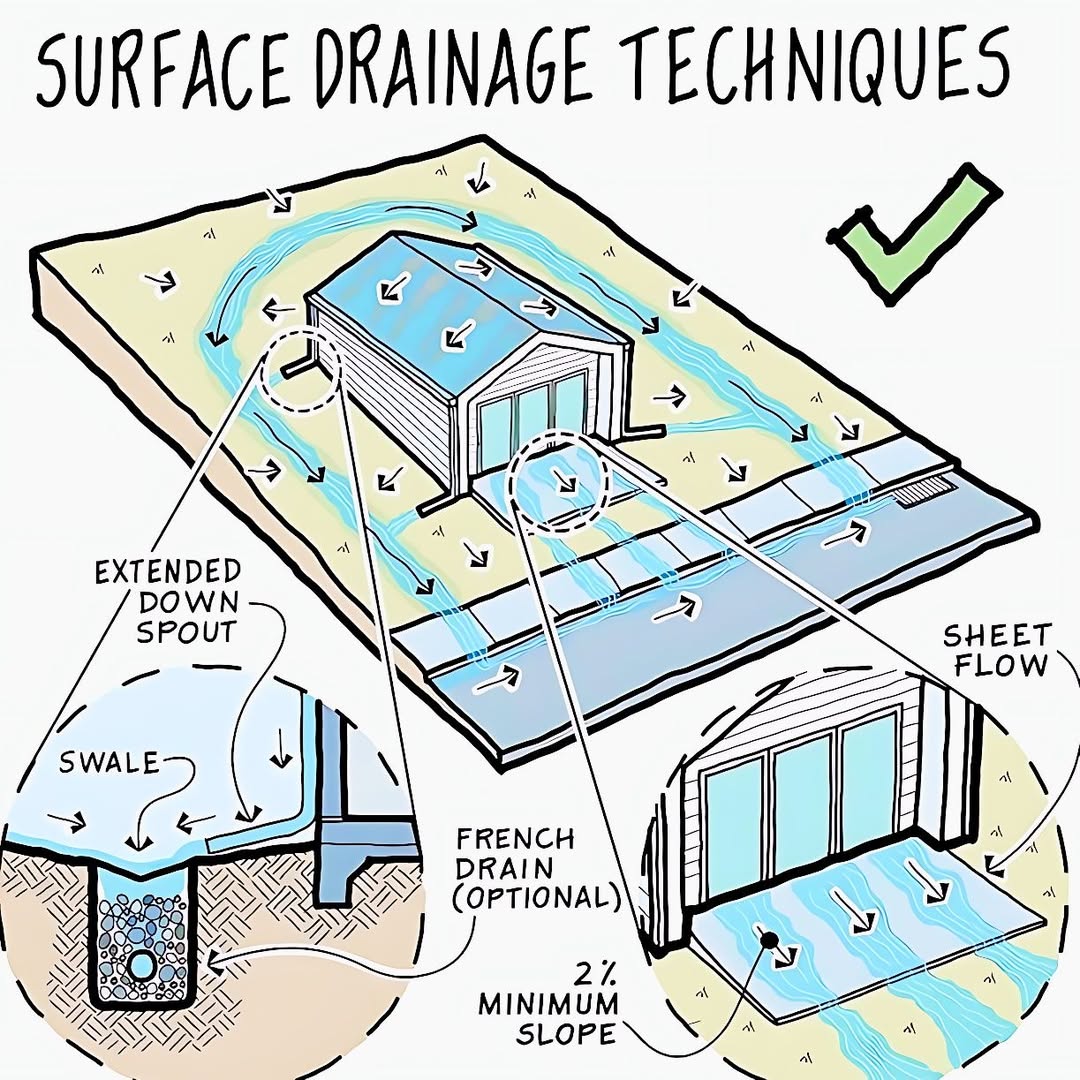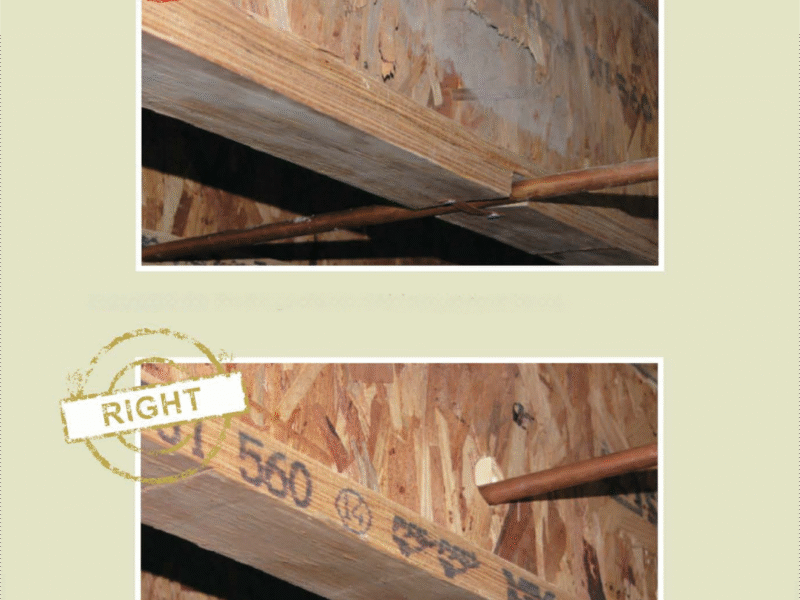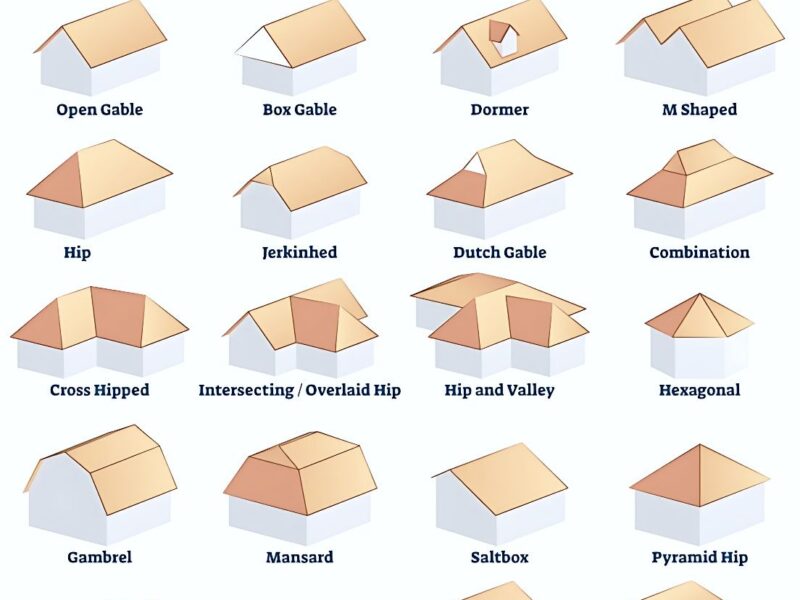best practices for managing stormwater runoff around a building, particularly a house with a basement or low-level entry. The goal of these techniques is to direct water away from the foundation to prevent issues like basement flooding, foundation damage, and erosion.
The main diagram shows a house on a slightly sloped landscape, with blue arrows indicating the intended flow of water. Two magnified insets highlight specific drainage techniques.
Overall Concept – Directing Water Away:
The central illustration demonstrates that water falling on the roof and surrounding landscape is guided away from the house’s foundation. The blue arrows show water moving away from the building on all sides towards lower elevations, sidewalks, or street drains.
Main Diagram Features:
* House: A typical house structure, likely with a basement or a ground-level entrance in the front.
* Roof Runoff: Water collecting on the roof is directed into gutters and then downspouts.
* Landscape Slope: The ground around the house is depicted with a gentle slope away from the foundation. The “2% MINIMUM SLOPE” annotation in the French Drain inset reinforces the importance of this grading. A 2% slope means for every 100 feet horizontally, the ground drops 2 feet vertically, which is sufficient to ensure water runoff.
* Paved Surfaces: A sidewalk and driveway (or patio) are shown leading to a street. These also have slopes to direct water.
Detailed Drainage Techniques (Insets):
1. Extended Downspout and Swale (Bottom Left Inset):
* Extended Downspout: The diagram shows a downspout (from the roof gutter) that extends horizontally away from the house’s foundation. This is crucial because if a downspout just ends at the foundation, all the roof water will collect directly there, potentially seeping into the basement.
* Swale: Beyond the extended downspout, a “Swale” is illustrated. A swale is a shallow ditch or depression in the ground, often gently sloped and vegetated. Its purpose is to collect and channel surface runoff away from the building. The blue arrows show water flowing into and along the swale, then being directed away.
* Underground Components: The swale also shows a cross-section with an optional underground perforated pipe wrapped in gravel and filter fabric (often referred to as a “French drain” or a component thereof). This helps collect subsurface water and prevents clogging, directing it to a suitable discharge point.
2. French Drain (Optional) and Sheet Flow (Bottom Right Inset):
* French Drain (Optional): The main diagram points to an area near the house’s foundation, specifically where a patio or paved area meets the building. The inset for the “Extended Downspout” actually provides the visual for a typical French drain cross-section (perforated pipe in gravel). A French drain here would collect water accumulating near the foundation and channel it away underground. It’s labeled “OPTIONAL” because proper surface grading and downspout extensions might be sufficient in some cases.
* Sheet Flow: The bottom right inset illustrates “Sheet Flow” from a patio or similar paved surface away from the house. “Sheet flow” refers to water flowing as a thin, continuous film over a relatively smooth surface, rather than concentrating into channels. The arrows indicate water moving smoothly off the patio.
* “2% MINIMUM SLOPE”: This critical detail is repeated, indicating that paved surfaces like patios and sidewalks should also be constructed with a minimum 2% slope away from the house to ensure effective sheet flow drainage.
Overall Purpose:
The diagram effectively communicates fundamental principles of effective surface drainage:
* Divert roof water: Get water from the roof away from the foundation.
* Grade away from foundation: Ensure the ground slopes away from the building on all sides.
* Manage paved surface runoff: Slope patios, driveways, and sidewalks to direct water away.
* Utilize natural landscape features: Swales and gentle slopes are cost-effective drainage solutions.
* Consider subsurface solutions: French drains can provide additional protection, especially in areas with poor soil drainage or high water tables.


